

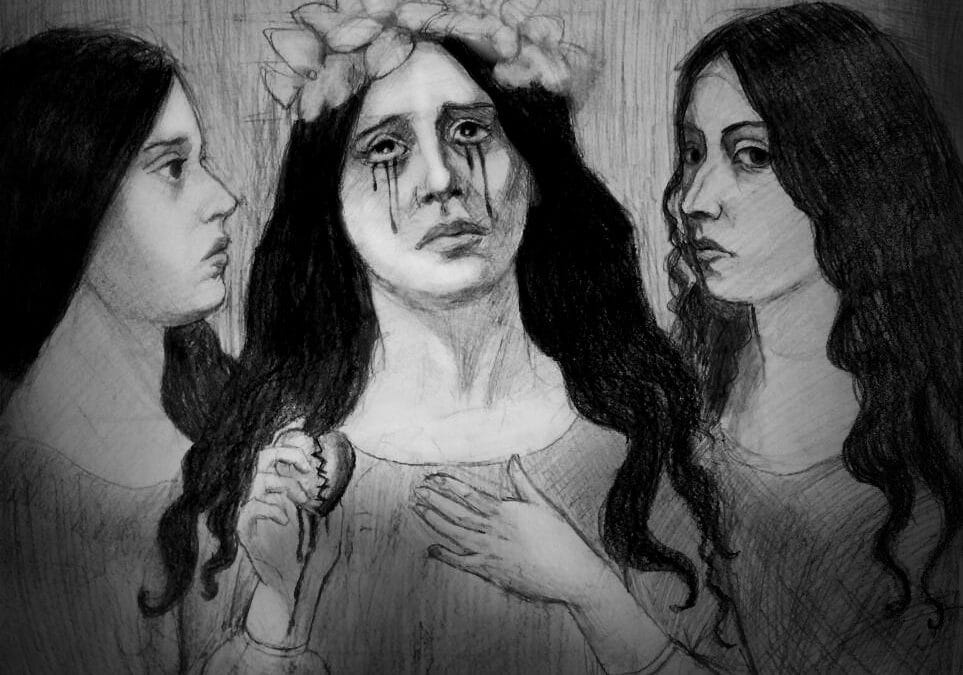
My Traumatizing Elementary School Experience
Healing Within, 2019, Graphite Pencil Drawing
Introduction
As an autistic woman and highly sensitive individual, my likelihood of developing trauma, anxiety, and selective mutism was significantly increased. My sensitivity, both physical and emotional, deeply shaped my experience, making me more vulnerable to trauma and ultimately influencing the development of my selective mutism. I have always felt things deeply—emotionally, mentally, and intuitively. I can sense energy, notice when something is off, and feel deeply connected to the emotions around me.
Childhood Experiences
In fourth grade, I experienced one of the first major shocks to my nervous system. Our teacher yelled at the class for failing a spelling test, and the weight of the words overwhelmed me with pain and sadness. I was only nine years old, and this marked the beginning of my anxiety disorder. I changed, becoming quiet and scared to express myself. Even something as simple as laughing or smiling became a source of anxiety because it would draw attention to me—a spotlight I desperately wanted to avoid. To prevent that embarrassment, I forced myself not to laugh or smile, which tensed my face and jaw. Looking back, I wonder if this even contributed to my TMJ.
I used to be an eccentric, funny kid, unafraid to be myself or share my thoughts. But that started to fade as I retreated inward, overwhelmed by school. I hated going and often stayed home with my grandmother, where I felt safe. Unfortunately, my mom was angry about my frequent absences, and by middle school, I had missed so much that I was sent to court. I often wished there had been a safe space for me, a place where I could receive therapy and support, rather than punishment.
One day in fourth grade, my teacher got enraged because I didn’t have a sheet of paper to write on. I was too nervous to ask my classmates, and when she noticed, she exploded, yelling that I was a spoiled brat and that I would fail the school year. She even said, “See you in fourth grade again next year!” All I had done was not have a paper, and her reaction was deeply traumatizing. I left the room, hyperventilating and crying, wishing I could disappear. I felt utterly alone, unworthy, and consumed by depression, with thoughts of dying clouding my mind.
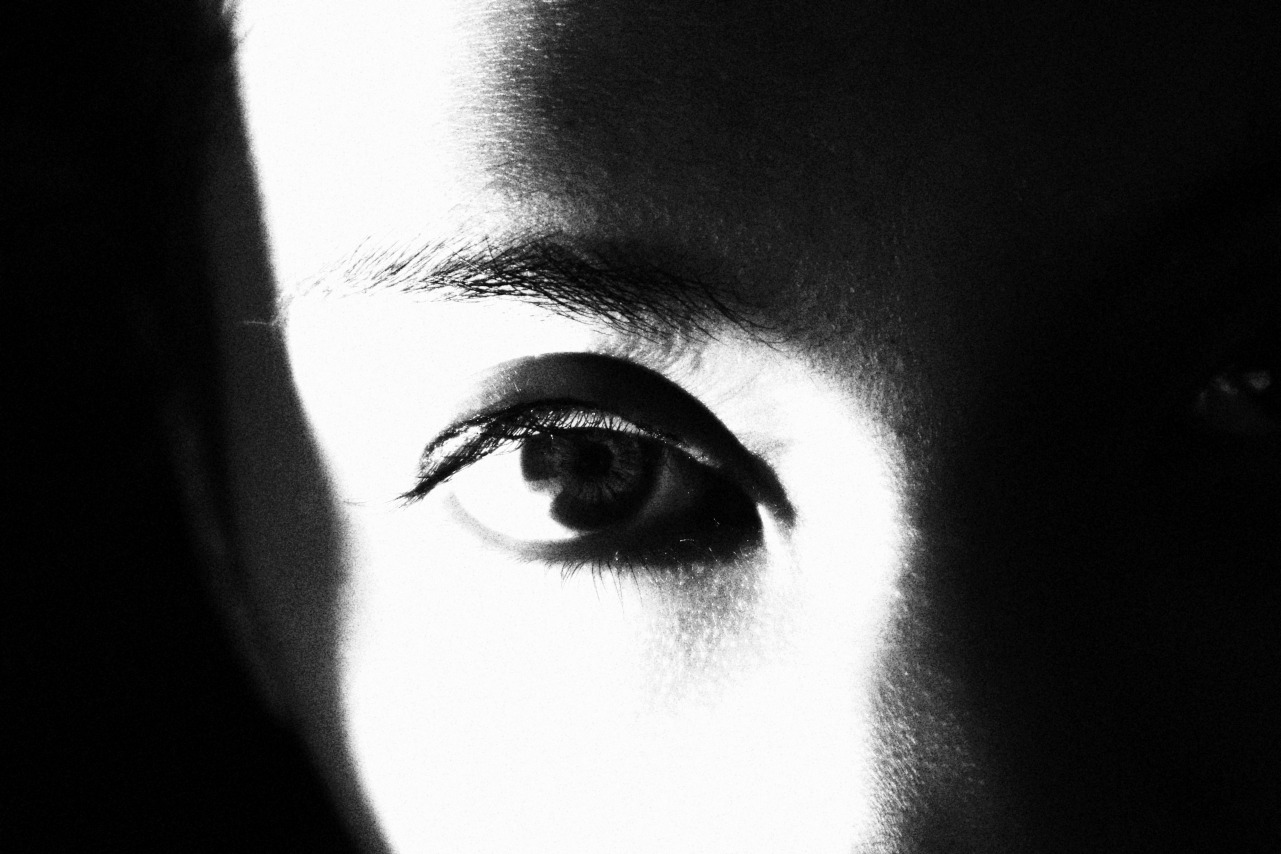
Angelina’s Eye, 2024, Photograph
Another memory that stands out was when I went to the school nurse for a sore throat. I didn’t want the other kids to see my mouth, so she sent them out of the room. After confirming my throat was red and sore, she refused to send me home because I had already missed too many days. I left the nurse’s office, crying and hyperventilating in the hallway, when a kind older woman—a faculty member—hugged me and asked, “Why are you crying? You’re too pretty to be crying.” In that moment of despair, I felt an unexpected kindness that I will never forget.
Another source of my trauma came from my gym teacher, Mr. S, who I encountered from fourth to fifth grade. I hated him. I loathed going to P.E. class and was haunted by vivid nightmares about him and that gym. After years of healing, the nightmares are less frequent and not as terrifying, but they linger. In fourth grade, I stopped participating in gym activities because of my anxiety, and Mr. S, like many other teachers, assumed I was being defiant. He punished me by making me walk in a line back and forth while the other kids played. Everyone disliked him—he ruled like a dictator, punishing the entire class for the mistakes of one student, even forcing us to write pages from books as punishment. During one such punishment, a classmate said, “I don’t know why Angelina is always getting into trouble. She never does anything wrong.” Those words stuck with me because I wondered the same thing—why was I always in trouble? What had happened to me?
My homeroom teacher wasn’t much better. At nine years old, I started my period, and one day at school, I didn’t have enough menstrual products and bled through my clothes. I kept going to the bathroom, and my male teacher asked me in front of the class what was going on. I was mortified. I told him, “I’m bleeding,” and he exclaimed, “Why didn’t you tell me?!” I was embarrassed beyond words. On another occasion, I was swapped with a student from another class. As I packed my things, kneeling on the floor while my teacher stood over me, he asked, “You know why we’re doing this, right?” I wasn’t sure if this was meant to be a punishment, but I ended up enjoying the switch. The teacher I was sent to was kind, and suddenly, in her class, my voice returned. I spoke louder, clearer, and without fear. It was as if I had rediscovered my old self.
Physical & Emotional Pain
In those dark times, I often closed my eyes and imagined a world where I felt safe, loved, and at peace. I envisioned characters from my favorite books and video games, spending time with them in this imaginary world. I drew them too, sketching late into the night as the sun began to rise. Art was my escape, my way of decompressing and relaxing my overtaxed nervous system.
The constant anxiety, stress, and trauma I experienced during those years not only affected me emotionally but also took a toll on my body. My muscles were often tense, and I developed chronic pain, particularly in my jaw and shoulders, from the stress of holding everything in. Not being able to fully relax or speak freely left my body in a state of perpetual tension. For years at school, I felt like I was on high alert, always bracing myself for something to go wrong. This chronic stress built up in my muscles, leading to soreness and discomfort that I struggled with even as I got older. It was as if my body had absorbed the emotional pain I couldn’t express, and the weight of it stayed with me long after I left those classrooms. But now, I am finally learning to release this tension, both mentally and physically. Through my art, exercise, muscle massages, meditation, and journaling, I am slowly unraveling the knots of chronic pain. These practices have helped me reconnect with my body and heal the years of accumulated stress, allowing me to feel more grounded, relaxed, and at peace with myself.
Healing
Roses, 2024, Photograph
When I was 12, my mom took me to a psychiatrist, and I was diagnosed with autism and selective mutism. I was prescribed Risperidone, an antipsychotic, and Citalopram, an antidepressant. While these medications helped for a time, they also brought vivid dreams—some beautiful, others terrifying. I took them until I was 21, when I quit cold turkey, fed up with feeling like a zombie. The medications made me drowsy, and every time I voiced my struggles, the doctor simply increased the dosage. I felt like no one truly understood me, and I found more comfort and understanding from online resources and books than I ever did from the doctors.
I often wonder who I might have been if I had grown up with more confidence and security. But despite the darkness, I am grateful. I am more compassionate, empathetic, and kind because of what I went through. My experiences shaped me into someone who can help others, offering support to those who feel alone or misunderstood. If you’re reading this and feel like I did, please know that you are not alone. You are here for a reason, and you deserve to be your true self and pursue your dreams. I am proud of who I’ve become, and I forgive those who hurt me. They were likely hurt too, just doing the best they could with what they knew. I hope they know better now.
The world needs more kindness, compassion, and understanding.
Autism and Selective Mutism: My Journey
Me at 15 years old, doing creative photography
Autism
I was diagnosed with Autism at age 12, following stressful, traumatic experiences in elementary school. The trauma led to severe anxiety, which developed into selective mutism. As an autistic person, I feel emotions deeply, which increases my chances of experiencing anxiety and mutism.
Autism Spectrum Disorder (ASD) is a neurological condition that affects how the brain processes information. It can alter communication, sensory perception, and social interactions, often making daily life a challenge. Autism is often genetic, with signs appearing early in life. Some people, like me, have heightened sensitivities—disliking bright lights or loud sounds—while others struggle with processing verbal information. These sensitivities can make certain environments overwhelming.
Autism: Growing Up and How It Affects Me Now
Autism has shaped many aspects of my life. While I am not defined by it, autism is a part of me, and I wouldn’t be the same without it. One of the biggest challenges I face is auditory processing disorder (APD). Although my hearing test results show that I have above-average hearing, I struggle to understand spoken words, especially when there’s background noise. This delay in processing leaves me feeling disconnected at times. By the time I’m ready to respond, the conversation has often moved on, and I feel left out.
Sensory overload has also been a major struggle for me. In middle and high school, I sometimes had to leave the classroom to avoid a meltdown triggered by overwhelming noise or bright lights. Meltdowns happen when sensory or emotional overloads make it impossible for me to function. Over time, I’ve learned to recognize the signs of an impending meltdown and find ways to decompress.
Emotional and Physical Exhaustion
Being autistic can be exhausting. My brain processes more information than the average person’s, which often leaves me drained after social interactions or daily activities. This mental exhaustion manifests physically as headaches, tension, and sore eyes. Research shows that autistic individuals process environmental stimuli differently, which can lead to quicker burnout.
Auditory Processing Disorder (APD)
APD has affected me deeply. Even though my hearing is above average, my brain struggles to filter out background noise, making it hard to focus on conversations. This constant sensory overload can be physically and mentally draining.
Mood Swings and Emotional Sensitivity
I experience emotions intensely. When I’m happy, sad, angry, or frustrated, I feel these emotions much more strongly than others might. This emotional sensitivity, common among autistic people, can be overwhelming, especially when paired with sensory overload. My daily mantra has become: “I respond, not react.”
Meltdowns and Shutdowns
When emotional or sensory overload becomes too much, I either have a meltdown or a shutdown. A meltdown is an intense nervous system response to overstimulation, while a shutdown is when my body or mind “freezes” in response to overwhelm. Over the years, I’ve learned how to manage these responses, practicing deep breathing and seeking quiet spaces when I sense one coming on.
Stimming as a Coping Mechanism
One of my primary coping mechanisms is stimming—repetitive actions that help regulate my nervous system. I have various stims, such as smelling my hands or arms and vocal stimming through sounds or repeating phrases. These actions bring me comfort and help me release pent-up tension.
Masking and Burnout
Another challenge has been masking—suppressing my natural behaviors to fit in. For a long time, I didn’t even realize I was doing it. Masking can help you blend in, but over time, it leads to burnout. Pretending to be someone else was exhausting and damaging to my mental and physical health. Now, I’m focused on unmasking and embracing my true self without worrying about societal expectations.
Selective Mutism
Selective Mutism (SM) is a severe anxiety disorder where a person cannot speak in certain social situations, despite being able to speak comfortably in others. It isn’t a choice—it’s a “freeze” response to fear. I struggled with SM from ages 12 to 14. No matter how much I wanted to, I couldn’t speak in public or at school. My body tensed up—my mouth, throat, chest, and stomach always felt tight. The anxiety didn’t leave until I got home, where I could finally relax.
Though it’s called “Selective Mutism,” I didn’t choose it. I wasn’t being silent on purpose; it felt like I physically couldn’t speak. The experience was painful and isolating. Some questioned my intelligence because I wasn’t speaking, which made me feel like I had lost a part of myself.
Overcoming Selective Mutism
High school was the turning point. As a freshman, I was still mute, but I knew I didn’t want to continue living that way. Slowly, I started to speak again, though it was incredibly difficult. Without the help of a therapist, I had to push through on my own. Year by year, I made progress, and by senior year, I was speaking more confidently. My resilience, along with the support of my family and kind teachers, helped me overcome SM. Overcoming challenges requires self-determination, and while outside support helps, real change had to come from within me.
Releasing Trauma and Tension
Years of anxiety, stress, and trauma left me with chronic pain and tension in my muscles. Because I couldn’t speak or relax during my school years, my jaw, chest, and other muscles were constantly tight. Now, I’m finally learning to release this pain. Through exercise, massages, meditation, and journaling, I’m healing both mentally and physically. I’m letting go of the trauma stored in my body for so long.
Loneliness and Isolation
Loneliness has been a constant companion, especially during my teenage years. Diagnosed with autism and SM at 12, I felt disconnected from my peers. I desperately wanted to communicate, but mutism kept me trapped. Even today, despite my intelligence and wisdom, I sometimes feel like I’m playing catch-up. But I’ve learned that it’s okay to be different and to embrace my unique journey.
Rebirth, Charcoal Drawing, 2023
Moving Forward
The journey to becoming my authentic self has been long and difficult, but I’m finally learning to embrace who I am. I no longer want to hide behind masks or live in fear. By sharing my experiences, I hope to inspire others who feel isolated or misunderstood. You are not alone. The world is vast, and there is space for you to grow and thrive. Now, at 24, I’m proud of how far I’ve come. I wish I could go back and hug my younger self—the scared, lonely girl—and tell her there’s nothing to fear. Life is precious, and there’s so much beauty to explore.

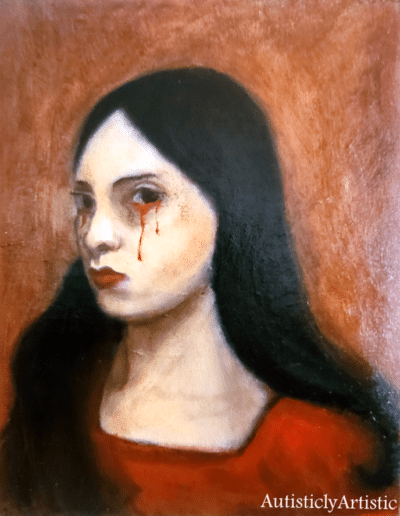
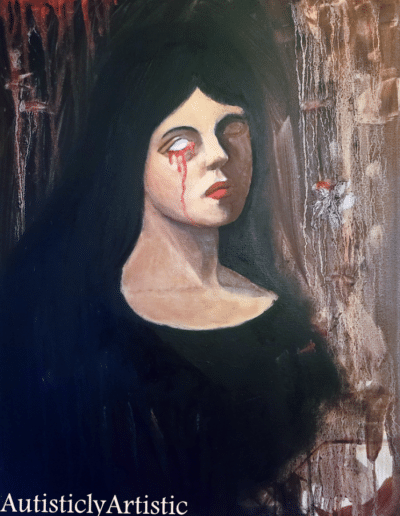

Recent Comments